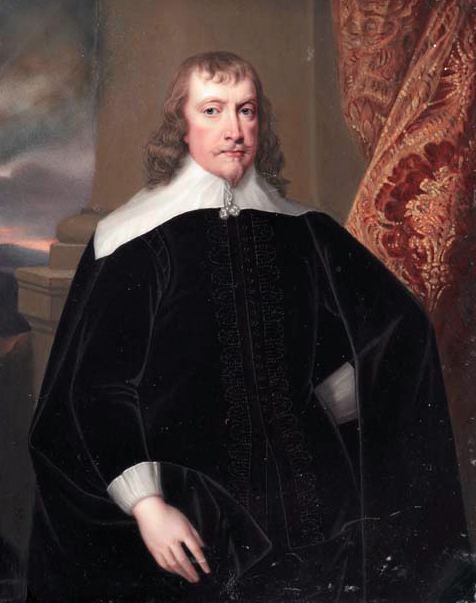Name Francis 4th Role Politician | Died May 9, 1641 | |
 | ||
Parents William Russell, 1st Baron Russell of Thornhaugh Spouse Catherine Brydges (m. 1609), Hon. Catherine Brydges Children William Russell, 1st Duke of Bedford, Edward Russell Grandchildren William Russell, Lord Russell Similar People William Russell - Lord Rus, George Digby - 2nd Earl of Bri, Edward Russell - 1st Earl of Orf, Robert Greville - 2nd Baro, Edward Montagu - 2nd Earl | ||
Francis Russell, 4th Earl of Bedford PC (1593 – 9 May 1641) was an English nobleman and politician. He built the square of Covent Garden, with the piazza and church of St. Paul's, employing Inigo Jones as his architect. He is also known for his pioneering project to drain The Fens of Cambridgeshire.
Contents
Early life
He was the only son of William Russell, 1st Baron Russell of Thornhaugh and his wife Elizabeth Long, to which barony he succeeded in August 1613. For a short time previously he had been Member of Parliament for the borough of Lyme Regis. In 1623 he was made Lord Lieutenant of Devon and on 3 May 1627 became Earl of Bedford on the death of his cousin Edward Russell, 3rd Earl of Bedford.
In 1621 Russell was one of the thirty-three peers who petitioned James I on the prejudice caused to the English peerage by the lavish grant of Irish and Scottish titles of nobility. In 1628, during the debates on the Petition of Right, he supported the demands of the House of Commons, and was a member of the committee which reported against the king's right to imprison. In May he was sent down to Devon, ostensibly to assist in refitting the fleet returned from Rochelle, but according to report, on account of his opposition in the House of Lords. Bedford was one of the three peers implicated in the circulation of Sir Robert Dudley's Proposition for His Majesty s Service (the others being William Seymour, Earl of Hertford and John Holles, 1st Earl of Clare), was arrested on 5 November 1629, and was brought before the Star-chamber. The prosecution, however, was dropped when the real nature of the paper was discovered, and Bedford was quickly released.
Politician of the parliamentary crisis
The Short Parliament meeting in April 1640 found the earl as one of the King Charles I leading opponents. He was greatly trusted by John Pym and Oliver St John, and is mentioned by Clarendon as among the “great contrivers and designers” in the House of Lords. In July 1640 he was among the peers who wrote to the Scottish leaders refusing to invite a Scottish army into England, but promising to stand by the Scots in all legal and honourable ways. His signature was afterwards forged by Thomas, Viscount Savile, in order to encourage the Scots to invade England. In the following September he was among those peers who urged Charles to call a parliament, to make peace with the Scots, and to dismiss his obnoxious ministers; and was one of the English commissioners appointed to conclude the Treaty of Ripon.
When the Long Parliament met in November 1640, Bedford was generally regarded as the leader of the parliamentarians. In February 1641 he was made a privy councillor, and during the course of some negotiations was promised the office of Lord High Treasurer. He was essentially a moderate man, and seemed anxious to settle the question of the royal revenue in a satisfactory manner. He did not wish to alter the government of the church, was on good terms with Archbishop Laud, and, although convinced of the guilt of Strafford, was anxious to save his life. In the midst of the parliamentary struggle Bedford died of smallpox on 9 May 1641.
Clarendon described him as "a wise man, and of too great and plentiful a fortune to wish the subversion of the government," and again referring to his death, said that "many who knew him well thought his death not unseasonable as well to his fame as his fortune, and that it rescued him as well from some possible guilt as from those visible misfortunes which men of all conditions have since undergone."
Estate development
In about 1631 with architect Inigo Jones he built the square of Covent Garden, with the piazza and church of St. Paul's. He was threatened with a Star-chamber suit for contravening the proclamation against new buildings, but the matter seems to have been resolved by compromise.
Bedford was the head of those who undertook to drain the great level of The Fens of Cambridgeshire, which were renamed the "Bedford Level" in his honour. He and the other undertakers were to receive ninety-five thousand acres of land, of which twelve thousand were to be set apart for the king, and the profits of forty thousand were to serve as a security for keeping up the drainage works. He spent a large sum of money over this work, and received 43,000 acres (174 km²) of land; but the project involved him in great difficulties. By 1637 he had spent £100,000 on the undertaking but after various jealousies and difficulties the king took the work into his own hands in 1638, making a further grant of land to the Earl. The work was not declared finished till March 1653, twelve years after Bedford's death.
The 4th Earl is buried in the 'Bedford Chapel' at St. Michael’s Church, Chenies.
Children
Bedford married Catherine Brydges (d. 1657), daughter of Giles Brydges, 3rd Baron Chandos. They had eight children:
